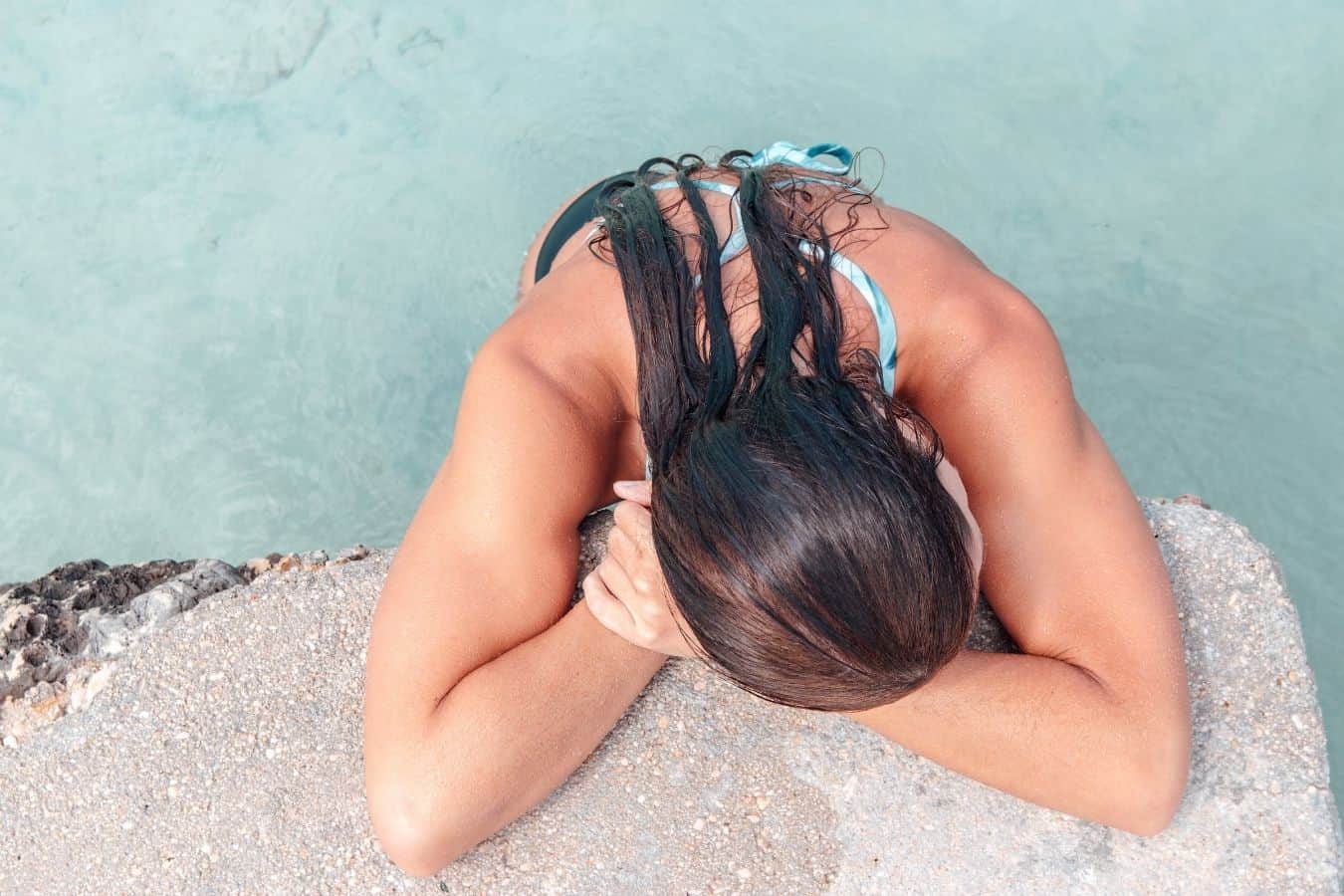If you’re a devotee of either permanently or semi-permanently dyeing your hair, there’s no better feeling than returning from the salon with a fresh color of hair. If your salon trip is in the heat of the summer months, however, you may want to wait a few days before going swimming with semi-permanent hair dye.

You need to wait a minimum of 48 hours, but ideally, 72 hours, before you go swimming if you’ve just treated your hair with semi-permanent hair dye.
Below, we detail exactly why you need to wait this long before going swimming with semi-permanent hair dye.
This is whether you’re planning for a dip in the sea or a few laps in the pool.
We’ll also advise on the best strategies by which to help preserve your semi-permanent hair dye for as long as possible if you are keen on swimming.
Read on for more.
How Long After Dying My Hair Can I Go Swimming?
Your hair dye – whether semi-permanent or permanent – needs time to penetrate into the shaft of your hair and really transform its color.
For this reason, you need to be waiting at least 48 hours before you go swimming after having dyed your hair with semi-permanent or permanent hair dye.
This is for a couple of reasons.
Chlorine, salt water, and ultraviolet exposure cause the pigments in semi-permanent dye to fade quicker.
Chlorine will fade your hair dye pigments by up to 60%. When you swim, you increase the amount that you need to wash your hair, which will only encourage the dye to fade faster.
So, although you won’t ruin your hair color if you go swimming with semi-permanent hair color, you’re also not helping your hair to retain that color.
Does Semi-permanent Hair Dye React With Chlorine?
Before we go into detail about how semi-permanent hair dye reacts with chlorine, it’s useful to understand why chlorine is even added to pool water in the first instance.
With so many bodies entering an essentially static body of water, the risk of germ exposure for those swimming in a pool is fairly high.
That’s why chlorine is added. It kills germs that can cause nasty viruses and will also battle bacterial infections.
Chlorine is a chemical. In fact, it’s actually naturally occurring and is produced via a process called electrolysis from ordinary salt.
But it is still a disinfectant. As a chemical, it will react with the elements of your hair dye.
Typically, chlorine will bleach hair, stripping it of its color.
Chlorine could therefore end up causing unattractive stripes of ginger or blonde streaking through your hair.
Chlorine will also strip hair of its moisture. This is a particular problem if your hair dye is drying, as you’re compounding the process and might end up with dry, brittle, easily breakable locks.
Like hair dye, chlorine can be harsh on your scalp, causing irritation and dryness. This is why some people even believe that using hair dye will kill lice.
All of that said, there is some anecdotal evidence that swimming with dark semi-permanent hair dye, rather than permanent, is better than swimming with lighter semi-permanent hair dye.
The color will still fade faster, but you are less likely to experience hair discoloration.
Does Seawater React With Semi-permanent Hair Dye?
There’s something about your hair after you’ve been for a swim in the sea.
Sea salt works to add bounce, volume, and texture to hair. That’s why there are so many sea salt haircare sprays on the market.
Your hair is more likely to fall in beachy waves after swimming in the sea. But is this also the case if you have semi-permanent hair dye?
Yes and no. Seawater, as you know, is full of salt.
This is less likely to adversely react with either semi-permanent or permanent hair dye than chlorine, but your hair will still experience some color fading if you go sea swimming with semi-permanent hair dye.
Your hair is also likely to become more brittle and dehydrated if you regularly change its color and swim in the sea.
Sea salt is hygroscopic, meaning that it strips hair strands of their moisture. If your semi-permanent hair dye is prone to drying hair anyway, then you’re exacerbating the problem, which may result in lifeless, dry hair.
Plus, if you’re washing your hair more in order to get out the sea salt, you’re going to gradually cause the color to fade.
Can I Go Swimming With Permanent Hair Dye?

Permanent hair dyes are inevitably stronger than semi-permanent hair dyes.
They specifically work by penetrating your hair’s cuticle, so are made of stronger chemicals and have to be left to apply for a longer time.
These chemicals can include potent compounds such as ammonia and/or hydrogen peroxide. This is also why it’s harder to remove permanent hair dye from your skin.
Inevitably, there may be some damage to the strands of your hair in the process of permanently dyeing them.
Some shine and elasticity may be lost, and your hair might also become less strong in the process and more prone to breakage.
The chemicals in permanent hair dye are more likely to react badly with chlorine in the water.
If you’re planning to go swimming with permanent hair dye, you might want to consider covering your hair with a swimming cap or factoring a deep conditioner or oil into your haircare routine.
That way, you’re helping hair to restore and support its natural moisture levels and trying to mitigate any damage done by either the chlorine or saltwater.
You can also read on for further tips and tricks for protecting dyed hair when swimming.
Can I Dye My Hair After Swimming In The Ocean?
Perhaps you’re strapped for time and are keen to touch up your roots after a session of sea swimming. Perhaps you’ve bleached and dyed your hair on the same day.
We understand the pressures of fitting everything into your daily schedule.
But in all honesty, it’s not advisable to dye your hair with either semi-permanent or permanent hair dye immediately after swimming in either the ocean or pool.
In an ideal world, you want to be heading to a salon, so that they can give your tresses the care and attention they really need.
Salons are more likely to offer both a deep cleansing and moisturizing treatment in advance of dyeing hair, which will then help the dye to penetrate deeper and last for longer.
Plus, who doesn’t love taking time out for a bit of your time – why not head to the salon with a great book or magazine and let someone else do the hard work?
If you’re set on coloring your hair at home straight after a swim, you could try mixing conditioner with hair dye to protect your strands from drying out.
Swimming With Bleached And Highlighted Hair
If you regularly bleach your hair, you’ll know that it requires a significant amount of time and effort.
When you bleach your hair, you strip it of its natural color.
There’ll usually be two agents involved in this process. One is an alkaline agent which opens the hair cuticle up in readiness for the color.
Next, you’ll have an oxidation agent applied. This penetrates the hair and allows color to attach in place of your natural shade.
We would strongly advise against swimming in a pool with bleached hair.
Have you ever seen someone emerge from the water, only to discover green stripes through their bleached hair?
This is a typical consequence for those that go swimming with bleached hair.
Swimming in the ocean will also cause bleached hair to dry out, stripping it of any natural oils.
Swimming with highlighted hair is also not the best idea. Inevitably, the chlorine will cause highlights to fade faster, so you’ll have to get them touched up more often. You then need to be taking steps to lock in any moisture that your hair does have.
Thankfully, we’ve detailed the steps that you can take in order to protect semi-permanent or permanent hair dye when you go swimming below.
Ways To Protect Semi-permanent Hair Dye When Swimming
Here are a few ways to protect your dyed hair when swimming:
Use A Swim Cap
Okay, they’re not very glamorous, and they may make you feel like a child back in school swim meets, but a swim cap works.
It is a barrier between your semi-permanent hair dye and the chlorine or saltwater, and will therefore work to minimize any fading or color stripping.
If you really don’t want to wear a swim cap, put your hair up, and keep your head and hair out of the water.
Wet Your Hair Before Swimming
Before you jump in the water, head to the nearest shower.
This is easier if you’re planning to swim in a pool, but most beaches will also have a shower somewhere.
As your hair absorbs the water from the tap, it swells, which means it’s less likely to absorb salt water or chlorine.
As such, your hair is less likely to suffer from the negative effects of either, and your dye will last longer.
Use The Right Shampoo
You need a shampoo that’s specifically designed for your hair dye. Dyed it blonde? Get shampoo for that color.
If you want to really help preserve your color, massage this shampoo into your hair and scalp. Leave it on for 20 minutes, and then continue with your regular hair care regime.
This will help the dye pigment really penetrate and last longer. Equally, even though it can be tempting to go immediately from the water to your next big plan, you need to take the time to wash either the chlorine or salt from your hair.
By letting it sit in your locks, you’re only encouraging the dye to fade faster.
Moisturize
Semi-permanent hair dye and swimming isn’t the best combination. However, you can help hair to retain its color and moisture levels by giving it a bit of help.
Coat your strands in either coconut or olive oil prior to swimming. This will create a barrier between the chlorine or salt and the pigments in the hair.
You can also use oils after swimming as a deep moisturizing treatment.
Alternatively, grab a leave-in conditioner or mask and allow its intense hydration to restore your hair’s elasticity and bounce.
Use Hair SPF
Um hello, yes, your hair really does need SPF, just like your skin.
Just like sun cream, you want to be looking for hair products that will protect against both UVA and UVB. Your tresses will really thank you.
Disclaimer: This site is not intended to provide professional or medical advice. All of the content on LovedByCurls.com is for informational purposes only. All advice should be followed at your own discretion. Ingredients may change at any time so always check the product label before using. Check our full disclaimer policy here.
